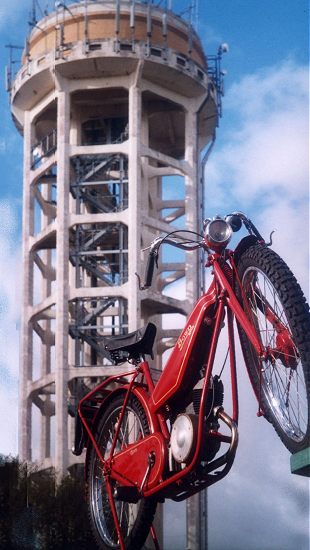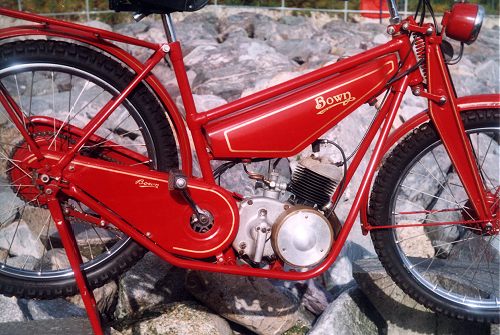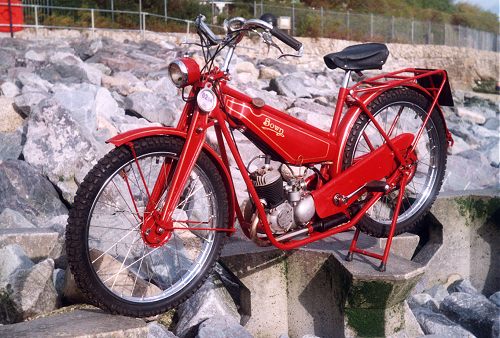 Go
to the Archive index
Go
to the Archive index
Structural Engineering: the duplex frame
Bown autocycle in front of
Spriteshall Water Tower.
"Since 1860" it says on the badge, "South Wales". Scattered fragments in time of a story that started in Birmingham with the engineering of parts for sewing machines and hair clippers, roller skate wheels in 1876, Aeolus ball bearings in 1879, and the brief appearance of Aeolus motor cycles in 1914 - produced by a certain Bown Ltd. The Aeolus brand disappeared in 1916, though the same machines actually returned to the market in 1919 under Bown's own badge, continuing until the mid '20s, when the business relocated to Chadwell Heath in Essex and made specialist bicycles. Around halfway through the 1930s the company became absorbed by The Aberdale Cycle Co, based at Bridgeport Road, Edmonton, North London, and finding William A R Bown listed among the board of directors. March 1947 saw the announcement of an Aberdale autocycle powered by the Villiers Junior de Luxe motor, which continued in production into 1948, when Villiers notified its customers that the JDL was to be succeeded by a new 2F autocycle motor. A complete replacement autocycle was going to be needed, and along with the concept for a following light motor cycle, William Bown took the tasks in hand. The new Aberdale models were displayed at the Earls Court Motor Cycle Show in November 1948, to much acclaim from the press. To meet the 1949 selling season, production was scheduled to begin in March, but never happened due to the provision of a second plant under the Labour Government's Advanced Factories Scheme, so listing of the old Aberdale autocycle was extended to cover the 1949 season. The new manufacturing site at Llwynypia, Tonypandy, Glamorgan to produce both autocycles and motor cycles was titled the Bown Cycle Co Ltd and by February 1950 started delivering its new Welsh dragons to the dealers. Gone was the Aberdale brand on the petrol tank - the Bown had returned.

Offside view, showing the duplex frame
The bike was just that little bit different from everyone else's machines, with one unique feature - a twin front downtube chassis design for an autocycle before Norton had even got out their famous featherbed frame! Bown called its new cycle the "Auto Roadster". It certainly looked sturdy enough with its duplex frame, though the wide splay on the tubes below the engine did tend to the impression of appearing a little clumsy. Some practical components carried over from the Aberdale, employing the same Webb pressed-steel blade-girder forks (also adopted by New Hudson), and the Aberdale petrol tank with its distinctive nose. Wheels and tyres were now 21" × 2.25", and the exhaust was neatly tucked away between the frame rails, down behind the motor. Ample chainguards were fitted both sides, and the engine shielded behind steel panels that filled the remaining frame space. Like so many period autocycles, our test machine no longer has these sidepanels. Revolutionary design seems to fizzle out beyond the frame though, as the Roadster still employs the outdated and cumbersome rear stand, which clips up at the back mudguard then locks with a lever for double security. Control fittings are all very traditional: pullback handlebars, lever throttle, inverted brake levers front and rear, manual griplock clutch, decompressor, single-position direct lighting, and squeezy bulb horn. The choke shutter is operateded by a linkage rod on the left-hand side that would have allowed its operation beyond the sidepanels, while a port in the panel permitted access to the carb flood button. On the stand, a firm rotation of the pedals while decompressed gets the engine turning over, then release the lever and the engine readily announces that it's running with a raucous bark from the exhaust.
Swinging a leg over the frame, you settle onto the mattress saddle, which appears the part, but suffers saggy old springs. The tall riding position looks down along the long slender cycle, and rest onto the pullback handlebar grips - a nice natural position, with the feel from the outset that everything is in just the right place. Release the griplock to let out the clutch, turn up the throttle lever, and a light boost on the pedals to ease the motor into a smoothly controlled take-off. With 99cc of Villiers 2F torque and 8:1 compression ratio these things are so much more leisurely than on a moped. Lovely, no revs, no drama - just cool and classy! Some of these later autocycles have a riding position like a sack of old potatoes, but I really like the posture on the Bown. You can sit upright to cruise right-handed and just tweaking the throttle lever, then place both hands on the grips to naturally fall into a slightly sporty forward lean. Control function is the usual distinctly separate operations of clutch and throttle or back and front braking, and not particularly helped by the somewhat cluttered lever positioning. It's a slow deliberate method of piloting these machines, but easy enough when you've adjusted to it.
Our test machine was recovered from a dreadful rusty pile of rotted scrap, requiring very essential wheel rebuilds using compatible modern rims with trail tyres. The tread pattern makes the ride rather skittish on the road, but they look tough, and come into their own when scrambling the bike down the beach and over the rocks at Cobbolds Point for the photoshoot. Then accompanied by a 1950 James Superlux 2F autocycle we roar on down to Ferry Hamlet, then face back into a South header for the return leg. This is when the Villiers motor really comes into its own - slogging into a strong headwind, where a moped would surely be battered down. Both machines are unperturbed and relentlessly lug their way against the oncoming weather conditions. So, what'll she do? Well, it was quite a blustery day when we did the test, and best speed was taken on the flat with a strong tailwind and rider sitting bolt upright. Leaving the James dropping away and reading from another pace vehicle, the Bown 2F Auto Roadster was clocked maintaining a steady 43mph! Such a surprise in fact, that I insisted we checked the drive ratio. Remove the front sprocket cover, count the teeth: 11, standard trim. Off with the carb, measure the bore: 7/16", standard! I dunno! There's no accounting why it goes so well, but it certainly does. It's not just that backwind either, since it was also paced pulling up to 40mph against a light incline in neutral air!
The front brake is adequately effective, though the rear is "very imbued with natural anti-lock qualities", if you know what I mean! Electrically, it may seem remarkable today that such a magnificent brass flywheel generator only puts something around 12W output to power the 6V lighting. With 3W rear and 10W front rated bulbs, the resultant illumination is best described as a "yellow dimness" and in reality is just something to be seen - rather than to see by.
In the absence of factory records, it's very difficult to grasp the actual numbers made. This example registered in August 1950 carries frame number BAU2279, though it is possible the numeration was continued on from the Aberdale series, which is certainly known to have reached frame AAU1328. 1950 was pretty much the beginning of the end for the autocycle era; demand only declined from this time. By the 1953 season, autocycle sales by all manufacturers had plummeted to only 1/3rd what they had been just 3 years previously. Bown must have been no exception to this situation as March 1954 saw them shedding 50 employees. Though all the machines enjoyed a well-made reputation, the entire range ceased production and the Welsh site closed at the end of the year. With the mighty BSA recording 3,000 New Hudsons in 1950, and AMC listing 2,000 Superlux at James, one can be pretty sure that Bown weren't going to be exceeding them! The 'continued numeration' theory seems quite likely, allowing about 1,500 Auto Roadsters in 1950. Plotting a comparative statistical decline with other autocycle manufacturers and allowing minimal 1954 production from the reduced workforce as the plant was winding down, the conclusion suggests only some 4,000 Bown autocycles being actually built - just the surviving frame numbers may confirm or disprove this, but BAU4870 is the highest serial so far recorded by the club. As further comparison, over at Norman, they only built a grand total 2,500 of their Model C autocycles between 1949 and 1957!
The Roadster was joined in 1951 by a 98cc motor cycle powered by a 1F engine, being replaced by the 4F when the new motor replaced it from October 1952. The final member to the family was a Villiers 10D powered 125cc motorcycle added in 1952, pretentiously titled the "TT" model, of which only some 200 are believed to have been built.

Nearside view
Having been made in relatively limited hand-built production, Bown models are very infrequently seen these days, and few would appear to have survived. The Auto Roadster is now a rather rare and special autocycle with one very classy chassis. The design and styling is a whole lot more striking than many of its contemporary stablemates. It rides that little bit nicer, the geometry feels that little bit better, and the engineering seems that bit more... quality. It's easy to love unusual machines for their rarity alone, but the Roadster really is an exceptional bike to ride and surely stands proudly on the rostrum of greatest autocycles. Riding a machine this good, one has to wonder how it ever came to be replaced by mopeds of the day. Maybe it all comes down to cost, but you only get what you pay for!
It wasn't all over for the Bown name though, since in November 1955 the badge re-appeared at the Earls Court Motor Cycle Show, adorning the tank of a new moped. In 1958, The Aberdale Cycle Company was acquired by Tube Investments and absorbed into the British Cycle Corporation, the last mopeds being built out during that year and unsold stock listed into 1959. This was to be the final year and the Bown brand never quite made its centenary.
We climb back aboard the NACC Time Machine, set the tumblers for the present day, and engage the travel lever. Suddenly, all the lights go out, there is a loud bang and a shower of sparks. As the emergency lighting comes on, we struggle to our feet. There must have been a major malfunction; the time dials are bouncing between the dates 1959 and 2003. Looking on the viewer, we are still outside the Bown factory, but now it is totally derelict. The doors to the capsule open automatically, inviting us out - and beyond? What if? A new machine awaits...
First published, December 2003